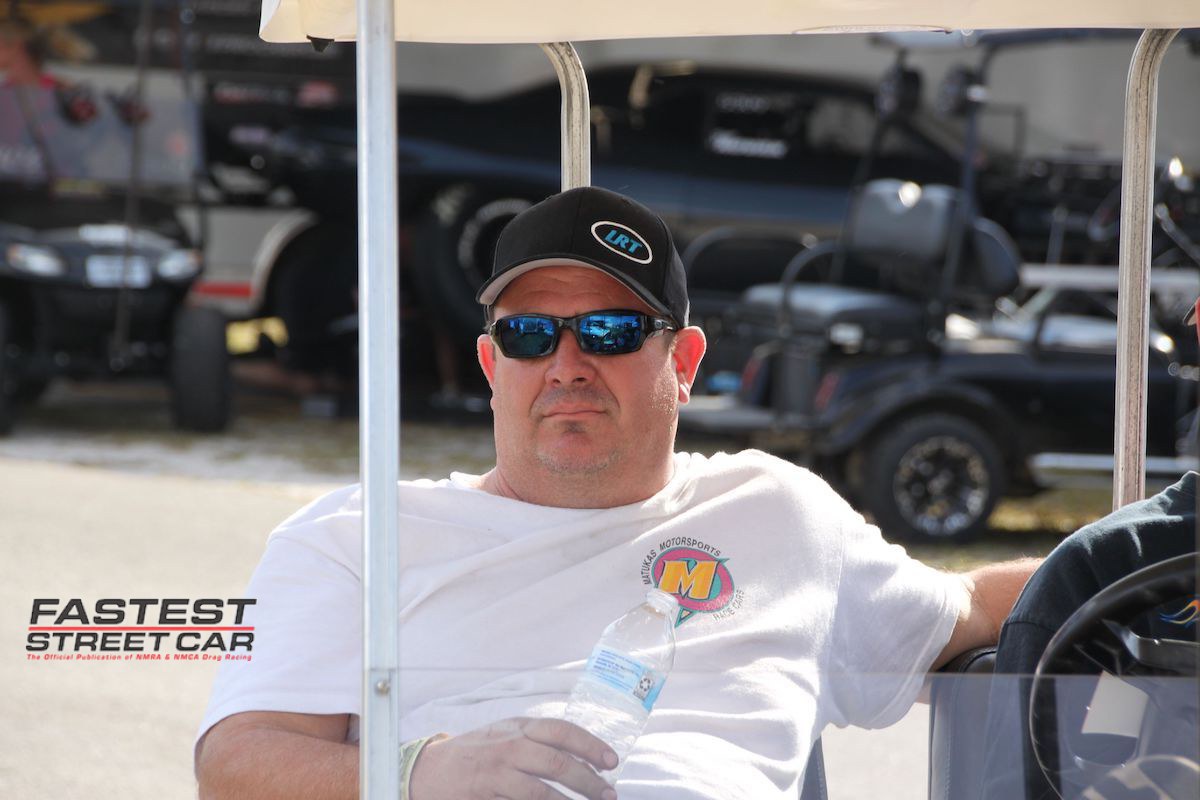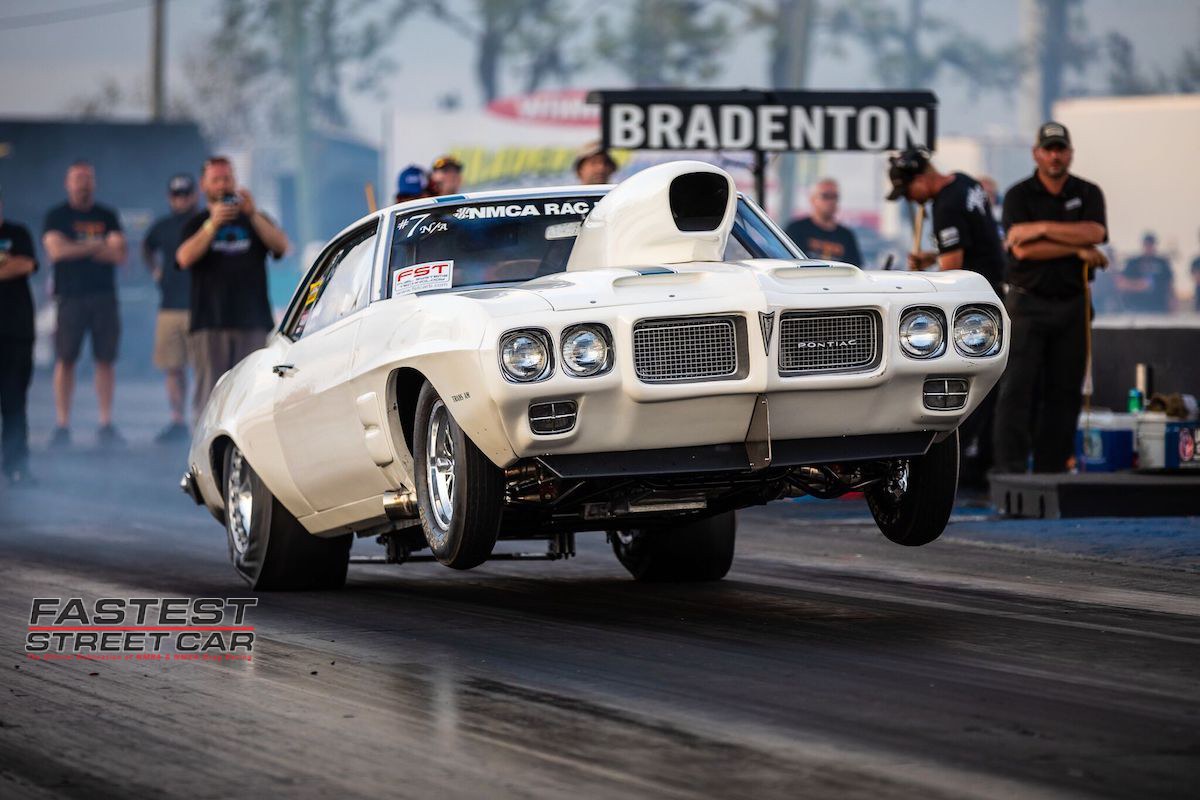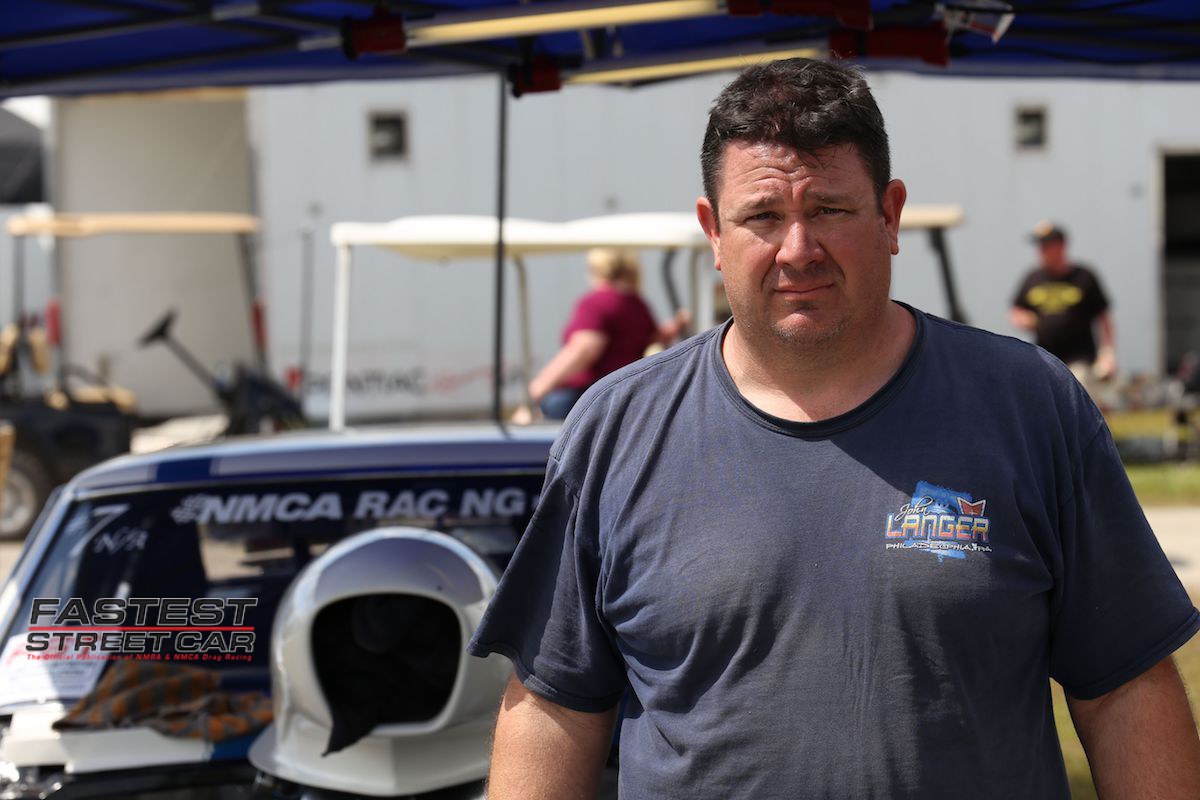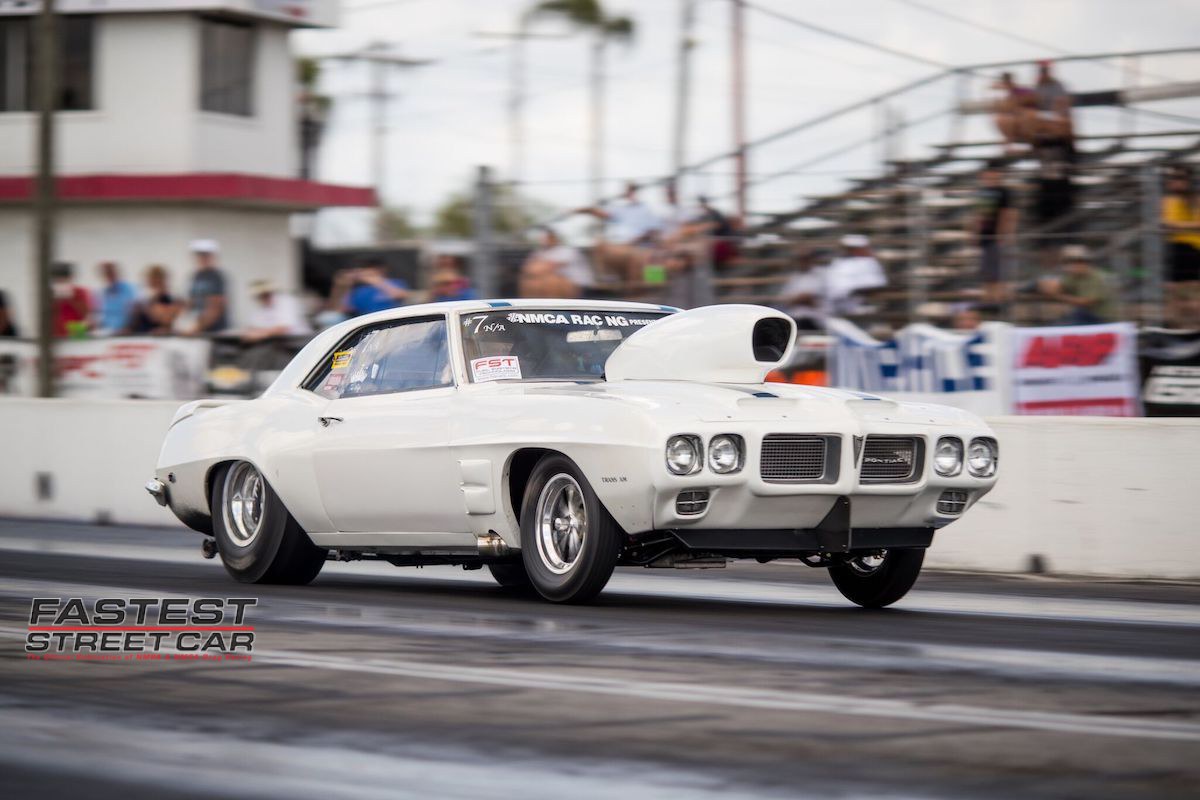Then, he would visit his father, an automotive mechanic, at work, and it wasn't long before he was reaching for the tools in his father's tool box.
By the time he was 19, Langer had his first car, a 1980 Trans Am, and it was around that time that he helped a friend find and purchase a 1969 Firebird. When his friend announced he was parting with it a year later, Langer purchased it for $2,000, with help from his mother, whom he promised to pay back.
It was, he said, his dream car, and after driving it on the street, he began taking it to the track. Then, after reading about the NMCA in magazines, he decided to dive into Real Street in 1997, followed by Pro Stock, where he earned a championship in 2006, and ultimately FST Carburetors NA 10.5, where he has been a consistently competitive contender the past several years.
Last winter, Langer strengthened an already strong race program by hiring Steve Matukas to rebuild his famous Firebird. He's just two races into the race season with what feels like a completely different race car, and he's already flying.
Read on for more about Langer, who lives in Philadelphia, Pennsylvania but whose work in the nuclear power plant industry temporarily has him in Augusta, Georgia.
WHEN DID YOU DECIDE THAT YOU WOULD HAVE YOUR FIREBIRD UPDATED
One of my best friends is Steve Matukas, who builds the best race cars in the country, and the last time we had upgraded the car was in 2008. For years, we were focused on finding more horsepower, and we neglected the chassis side of things, and there was so much to be had there, so two years ago, we started planning for some substantial upgrades. We knew we had to get the weight ballast right, the engine location right and the height right, and we had been planning on putting a bolt-in front suspension in the car. We knew we were going to leave no bolt unturned and upgrade the car to the best of the best stuff.
WHEN DID YOU TURN YOUR CAR OVER TO STEVE MATUKAS
I dropped it off at Matukas shop last November, and then in December, the rules for NA 10.5 opened up to allow four-links, so we said Okay. We're going to set the car up so that it could have a four-link or a ladderbar. Then we decided that we would put a Chuck Ford billet floater in it. Then, in January, Matukas, who's always very busy, pulled the car out of the trailer and stuck a beer can on the manifold.
WAS THAT THE SIGN THAT WORK WAS ABOUT TO BEGIN
I actually thought it meant that we weren't making the Bradenton, Florida or Atlanta, Georgia NMCA races, but Matukas worked on the car for 12-18 hours a day for 61 days straight, including a week of cutting the car apart, and at 10 p.m. every night, he would send me pictures of the progress. He kept saying We're going to Bradenton, and I'm like No way, and then one week before the Bradenton race, he sent me a text telling me to take the week of the Bradenton race off of work because he was going to be picking the car up from the person who painted it. I went to his shop in Kentucky and we worked 20-hour days from Saturday through Tuesday to put the car back together after all of the work he had done, and then on Wednesday morning the week of the Bradenton race, we fired it for the first time. Then, we rolled the car into the trailer and I drove back to where I'm staying in Augusta, Georgia with the car. With the exception of the sheetmetal on the car, the Funny Car cage, main hoop, steering wheel, rack and pinion and steering arms, we changed everything on the car from front to back.

WAS THE CAR RACE-READY AT THAT POINT, OR NOT QUITE
It wasn't done, and on top of that, when we rolled the car into the trailer, the driveshaft hit the crossmember, which we didn't know about until we went to unload the car in Bradenton. The driveshaft was in two pieces when we rolled the car out of the trailer. PST made me a new driveshaft, and we got it at 2 p.m. Friday. The car hadn't even been warmed up at that point, and they called NA 10.5 to the lanes. Matukas said Get your clothes on and drive the car to the lanes. Now remember, the only thing that was the same after the rebuild was the seat and the steering wheel. Even the gauges were different. So, I got up there, and I couldn't do a burnout, and I almost hit everyone on the starting line. Then, we knocked the tires off.
AND WITH THAT, THE FIRST PASS IN THE REBUILT CAR WAS COMPLETED AT THE 17TH ANNUAL NMCA MUSCLE CAR MAYHEM IN MARCH AT BRADENTON MOTORSPORTS PARK IN FLORIDA. WHAT DID YOU DO WHEN YOU GOT BACK TO YOUR PIT AREA
We put a tune in the computer, and then we went back up to make a second pass. The car launched to the left, but I still had my best-ever 60-foot time in NMCA trim of 1.173. When I went to shift into second gear with the new shifter, it went right into neutral. Before the next round of qualifying, we adjusted the anti-roll bar so that the car wouldn't go left, and we knocked the tires off and went 8.20 with big mile-per-hour, so we had something to work with. So, we back it down for the third round of qualifying, and I had a 1.21 60-foot with the back tires and the car was tracking left and I short-shifted, and I still went 7.87 at 174 mph to the quarter-mile, so then our spirts were high.
YOUR EFFORTS, AND YOUR 7.87, HELPED YOU QUALIFY IN THE THIRD SPOT. DID YOU FEEL A SENSE OF RELIEF GOING INTO ELIMINATIONS, OR WERE YOU STILL GETTING DIALED IN
The welds were still hot on the car from the rebuild and we brought it out and qualified in the third spot, so we were happy with that. But we wanted to keep going and do well on race day. We adjusted the suspension, and then we had Don Baskin in the first round of eliminations. The car came up on the wheelie bars and it was riding dirty for 80 feet. I pedaled it to bring it down, and went 8.03. I pulled the chute and it didn't come out and the brakes didn't have enough brake pressure to stop the car. I went off the track at the top end at 120 miles-per-hour. I saw just a narrow strip where there weren't pots of chili peppers growing in the sand, and I rolled through that.
EVERYONE WAS RELIEVED WHEN IT WAS ANNOUNCED THAT YOU WERE OUT OF THE CAR AND NOT INJURED. WHAT DID YOU DISCOVER WHEN YOU RETURNED TO YOUR PIT AREA AND INSPECTED THE CAR
I'm saying to myself, The front of my car is going to be ripped up, but there wasn't a scratch. Tech came to our pit area and asked if we were okay, and we said the car was fine and we began preparing for the second round of eliminations. We raced last year's champion, Dave Theisen, and when he knocked the tires, I was gone. I went into neutral in second gear again, but got the win. Then we had Leonard Long in the final round. We stepped up our tune-up and got a little aggressive, but my car started to shake the tires. I pedaled and it helped, but he got the win. It was the only time I was emotionless in a car. I had nothing left, physically and mentally, after everything we had done to get the car to that point. It was a major accomplishment. The car was gangster.
HOW DID YOU PREPARE YOUR CAR FOR THE 11TH ANNUAL SCOGGIN-DICKEY PARTS CENTER NMRA/NMCA ALL-STAR NATIONALS IN APRIL AT ATLANTA DRAGWAY
Because we had the wrong master cylinder for the style of brakes we had, we changed it and increased the brake pedal ratio to make sure we had pressure and changed out the chute cable.

YOU WENT ON TO POST A 7.84 TO QUALIFY IN THE SECOND SPOT IN ATLANTA. WERE YOU PLEASED WITH THAT, OR DO YOU FEEL YOU COULD HAVE LAID DOWN AN EVEN QUICKER ELAPSED-TIME
We ran a 7.85 at 174 mph right off the trailer, and we ran a 1.16 60-foot, which was our best ever 60-foot. When the air got a little better and we got more aggressive with the tune-up for the second round of qualifying, the car went left but we still ran 7.84. If it wasn't going left, we felt we could have run 7.82. Unfortunately, before the third round of qualifying, we went to start the car and the gear on the starter flew off. We didn't get to make that qualifier, but we replaced the starter and made it in time for the first round of eliminations. Don Baskin was broke, and when we went to make the pass, I couldn't get the car fired, and we timed out, so I was upset with that.
WHAT PREVENTED THE CAR FROM FIRING
Would you believe the 12-volt power wire that goes to the MSD box had broken I replaced the wire, fired the car up and drove it onto the trailer within minutes of that. We had worked so hard to get the car where it needed to be, and to have a minor electrical issue like that was very frustrating.
CONGRATULATIONS ON TAKING YOUR CHASSIS TO THE NEXT LEVEL. WHAT DO RELY ON FOR POWER
It's my tried and true 575 cubic-inch Pontiac engine built by Tony Bischoff at BES. It has an All Pontiac block and All Pontiac heads, a BES billet intake and a Book Racing carburetor. People don't understand how hard it is to get a Pontiac engine to go fast and to last, but there will always be a Pontiac engine in my car. I run a Dan Smith ProFlite that is serviced by Sean Wiley at Pro-Formance Transmissions. Sean (Wiley) is very helpful. PTC does my converters, and TRZ helps with control arms and front suspension. Anything that Moroso makes is on the car, and Jim Craig from Weldon has given me invaluable information for my fuel system while Greg Kelley from Motorsports Innovations has given me invaluable information about my RacePak. I tune the engine and Matukas tunes the chassis, and I use Mickey Thompson tires. The car has run a best of 7.61 at 179.44 mph, but that wasn't in NMCA trim. It was at the World Cup race last November.
YOU VE ALREADY ACCOMPLISHED SO MUCH, BUT WHAT ARE YOUR GOALS FOR THIS YEAR
In just 61 days, we took a championship-caliber car, completely gutted it and came out with something even better. We have one bad hot rod. I'll be honest with you. The class is a venue for me to show what I can do with a Pontiac, and my goal is to go faster than I did before every time I go to a race. I race against myself, not other people. After watching Dave Theisen, Leonard Long, Robbie Blankenship or one of the other drivers make a record-setting pass, I don't say I need to do that. Instead, I worry about how fast I can be, not about how fast someone else can be. Luckily, I have good help from Steve Matukas, The Godfather Scott Rex, Race Car Jimmy, Lupi, and my wife, Kristen.
(Interview from July issue of Fastest Street Car)



